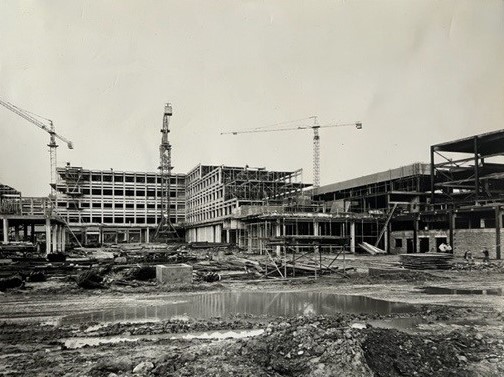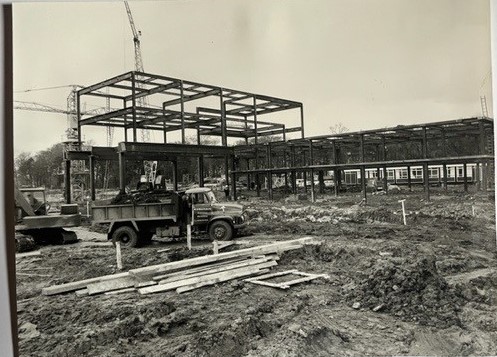And finally… Images of forgotten Glasgow building handed to museum

The National Savings Bank under construction
Photographs of the iconic National Savings Bank complex in Pollok have been handed over to Glasgow Life by Persimmon Homes to go on public display
Affectionately referred to as “a wee city in the heart of Pollok”, the National Savings Bank operated in the south side of the city between 1966 and 2015 and at the time, it was one of the largest buildings of its kind in Glasgow as well as one of the largest employers. As well as the Bank’s employees, the complex was also home to a wide array of shops and facilities – and even had its own newspaper to keep staff informed about local events.
When the site first opened in 1966, just 11 members of staff began working there. By the 1980s, the Bank employed more than 6,000 members of staff from across the west of Scotland. It was one of the largest employers in the area until 2015, when the decision was made to close the complex and relocate staff to Glasgow City Centre and East Kilbride.
In 2015, Persimmon Homes purchased the site and began work to create a new community, which required the demolition of the old buildings. Persimmon’s Boulevard development, which features more than 500 new homes, pays tribute to the influence of the Bank. Street names – such as Bond Drive, Investment Way and Penny Place – aim to ensure the area’s history is not forgotten.

The home builder has recently collated photographs of the old building complex that were discovered during the demolition process and is handing them over to the Glasgow City Archives to ensure they are preserved. The pictures give a detailed account of the creation of the National Savings Bank for the very first time.
The photographs and drawings were taken by the contractors who created the bank, who archived each stage of the building’s construction – from the demolition of nearby structures and the laying of foundations through to the end product.
Lord Provost Jacqueline McLaren welcomed Persimmon’s regional construction director, Alan Prickett, and Glasgow Life archivist, Nerys Tunnicliffe, to Glasgow City Chambers for the official handover of the images.
Alan Prickett, who was involved in the redevelopment of the site, said: “We first discovered the photos when we purchased the site of the old Savings Bank and stored them in our archives. But they should belong to the people of Glasgow and we are delighted to present them to Glasgow Life.
“Cowglen has a rich history and has been no stranger to redevelopment over the years. We hope that our Boulevard development marks the start of a new era for Cowglen, one that connects the area’s present with its past.”
Persimmon’s Alan Prickett presenting photos to Nerys Tunnicliffe and Lord Provost of Glasgow, Jacqueline McLaren
The archive of over 100 photos, along with several plans and drawings for the construction, will be stored by Glasgow City Archives. Pollok locals will now be able to get a glimpse of the archives and delve into the history of one of the south side’s most iconic buildings.
The Lord Provost said: “Thanks to Persimmon Homes these photographs have been saved for posterity as part of our city’s heritage and history. It’s great to know they’re now in the custody and safekeeping of our museum archives.”
Nerys Tunnicliffe, Glasgow City Archivist, said: “We’re delighted to receive these items to add to the collections here at the City Archives. It’s wonderful that locals and visitors to the city will have the opportunity to see these, and that part of Cowglen’s heritage can be preserved for the future.”
The area where the bank once stood has seen significant change over the years, with a Cowglen mine nearby and more recently the Cowglen Hospital, which served injured allied servicemen during the Second World War. The hospital, which closed its doors in 2001, was demolished and the land was later incorporated into Persimmon’s Boulevard development along with the bank.
The demolition of the bank and hospital paved the way for a new generation of property owners in Pollok who live within a stone’s throw of one of Scotland’s largest shopping centres, Silverburn, and a short drive to Scotland’s largest city.














